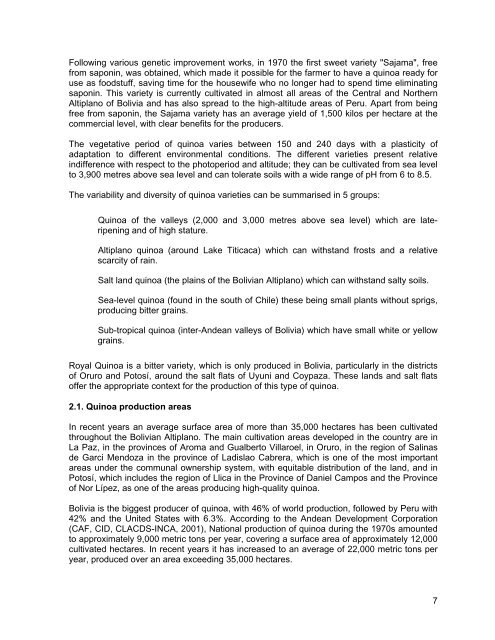Study on the social, environmental and economic impacts of quinoa ...
Study on the social, environmental and economic impacts of quinoa ...
Study on the social, environmental and economic impacts of quinoa ...
Create successful ePaper yourself
Turn your PDF publications into a flip-book with our unique Google optimized e-Paper software.
Following various genetic improvement works, in 1970 <strong>the</strong> first sweet variety "Sajama", free<br />
from sap<strong>on</strong>in, was obtained, which made it possible for <strong>the</strong> farmer to have a <strong>quinoa</strong> ready for<br />
use as foodstuff, saving time for <strong>the</strong> housewife who no l<strong>on</strong>ger had to spend time eliminating<br />
sap<strong>on</strong>in. This variety is currently cultivated in almost all areas <strong>of</strong> <strong>the</strong> Central <strong>and</strong> Nor<strong>the</strong>rn<br />
Altiplano <strong>of</strong> Bolivia <strong>and</strong> has also spread to <strong>the</strong> high-altitude areas <strong>of</strong> Peru. Apart from being<br />
free from sap<strong>on</strong>in, <strong>the</strong> Sajama variety has an average yield <strong>of</strong> 1,500 kilos per hectare at <strong>the</strong><br />
commercial level, with clear benefits for <strong>the</strong> producers.<br />
The vegetative period <strong>of</strong> <strong>quinoa</strong> varies between 150 <strong>and</strong> 240 days with a plasticity <strong>of</strong><br />
adaptati<strong>on</strong> to different envir<strong>on</strong>mental c<strong>on</strong>diti<strong>on</strong>s. The different varieties present relative<br />
indifference with respect to <strong>the</strong> photoperiod <strong>and</strong> altitude; <strong>the</strong>y can be cultivated from sea level<br />
to 3,900 metres above sea level <strong>and</strong> can tolerate soils with a wide range <strong>of</strong> pH from 6 to 8.5.<br />
The variability <strong>and</strong> diversity <strong>of</strong> <strong>quinoa</strong> varieties can be summarised in 5 groups:<br />
Quinoa <strong>of</strong> <strong>the</strong> valleys (2,000 <strong>and</strong> 3,000 metres above sea level) which are lateripening<br />
<strong>and</strong> <strong>of</strong> high stature.<br />
Altiplano <strong>quinoa</strong> (around Lake Titicaca) which can withst<strong>and</strong> frosts <strong>and</strong> a relative<br />
scarcity <strong>of</strong> rain.<br />
Salt l<strong>and</strong> <strong>quinoa</strong> (<strong>the</strong> plains <strong>of</strong> <strong>the</strong> Bolivian Altiplano) which can withst<strong>and</strong> salty soils.<br />
Sea-level <strong>quinoa</strong> (found in <strong>the</strong> south <strong>of</strong> Chile) <strong>the</strong>se being small plants without sprigs,<br />
producing bitter grains.<br />
Sub-tropical <strong>quinoa</strong> (inter-Andean valleys <strong>of</strong> Bolivia) which have small white or yellow<br />
grains.<br />
Royal Quinoa is a bitter variety, which is <strong>on</strong>ly produced in Bolivia, particularly in <strong>the</strong> districts<br />
<strong>of</strong> Oruro <strong>and</strong> Potosí, around <strong>the</strong> salt flats <strong>of</strong> Uyuni <strong>and</strong> Coypaza. These l<strong>and</strong>s <strong>and</strong> salt flats<br />
<strong>of</strong>fer <strong>the</strong> appropriate c<strong>on</strong>text for <strong>the</strong> producti<strong>on</strong> <strong>of</strong> this type <strong>of</strong> <strong>quinoa</strong>.<br />
2.1. Quinoa producti<strong>on</strong> areas<br />
In recent years an average surface area <strong>of</strong> more than 35,000 hectares has been cultivated<br />
throughout <strong>the</strong> Bolivian Altiplano. The main cultivati<strong>on</strong> areas developed in <strong>the</strong> country are in<br />
La Paz, in <strong>the</strong> provinces <strong>of</strong> Aroma <strong>and</strong> Gualberto Villaroel, in Oruro, in <strong>the</strong> regi<strong>on</strong> <strong>of</strong> Salinas<br />
de Garci Mendoza in <strong>the</strong> province <strong>of</strong> Ladislao Cabrera, which is <strong>on</strong>e <strong>of</strong> <strong>the</strong> most important<br />
areas under <strong>the</strong> communal ownership system, with equitable distributi<strong>on</strong> <strong>of</strong> <strong>the</strong> l<strong>and</strong>, <strong>and</strong> in<br />
Potosí, which includes <strong>the</strong> regi<strong>on</strong> <strong>of</strong> Llica in <strong>the</strong> Province <strong>of</strong> Daniel Campos <strong>and</strong> <strong>the</strong> Province<br />
<strong>of</strong> Nor Lípez, as <strong>on</strong>e <strong>of</strong> <strong>the</strong> areas producing high-quality <strong>quinoa</strong>.<br />
Bolivia is <strong>the</strong> biggest producer <strong>of</strong> <strong>quinoa</strong>, with 46% <strong>of</strong> world producti<strong>on</strong>, followed by Peru with<br />
42% <strong>and</strong> <strong>the</strong> United States with 6.3%. According to <strong>the</strong> Andean Development Corporati<strong>on</strong><br />
(CAF, CID, CLACDS-INCA, 2001), Nati<strong>on</strong>al producti<strong>on</strong> <strong>of</strong> <strong>quinoa</strong> during <strong>the</strong> 1970s amounted<br />
to approximately 9,000 metric t<strong>on</strong>s per year, covering a surface area <strong>of</strong> approximately 12,000<br />
cultivated hectares. In recent years it has increased to an average <strong>of</strong> 22,000 metric t<strong>on</strong>s per<br />
year, produced over an area exceeding 35,000 hectares.<br />
7

















